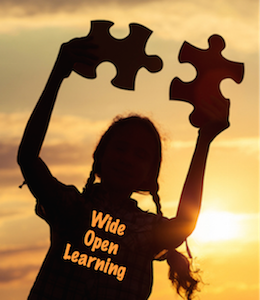Literacy Activities That Boost Content Learning
A MiddleWeb Blog
 In classes like social studies and science, students are expected to do complex nonfiction reading, but how can we ensure that they retain the content so that they can transfer it for future use?
In classes like social studies and science, students are expected to do complex nonfiction reading, but how can we ensure that they retain the content so that they can transfer it for future use?
One method is to ask students to represent the information in different forms, helping them grow their ability to think flexibly and critically.
These activities fall under “generalization” on the learning hierarchy and push students to use the information in a new way, making it more useful, and therefore, harder to forget.
These are some of the strategies that I have used in my classes. I am eager to add to the list.
Blackout Summaries
Writing blackout poetry is a literacy activity that I’ve used successfully for many years. After reading an article, students use markers to cross out words, leaving only a poem that summarizes what they’ve read.

Once the activity is complete, I like to have each table group choose the best from their team and then hang those around the classroom for a gallery walk. When they see the commonalities between the poems, it reinforces the main ideas of the text.
Scrambled Sections

In small groups, students read the sections and arranged them into what they thought was the correct order. Once they had read it through and were sure that they had it right, I gave them the original article, printed in a different color.
I liked the reasoning in student conversations that arose from this activity. As an observer, I was also able to see which students were using text features to achieve their goal.
Collaborative Responses
Each student in a table group gets their own color Post-it note, where they write their response to an open-ended question. They then share their responses with each other and decide upon the best, most thoughtful answer.
I would be careful with the pairings for this activity, as sometimes students assume they know who will have the best answer even when it isn’t the case. Each group then shares their chosen response with the class.
Tic Tac Tell

A student completes a Tic Tac Tell summary on the Nazca Lines.
I first learned about this activity from Glenn Weibe’s website many years ago. Vocabulary words related to the article are listed in a nine-block grid. Students then choose three words in a row to use in a paragraph summarizing their understanding. They highlight the selected words in the paragraph.
This would also be a fun way to start a class period by projecting a grid of nine important words from the previous lesson and asking students to share their understanding.
Rank the Evidence

I gave students eight Post-its, four of each color, and asked them to write one piece of evidence per Post-it that supports each side of the argument. Next they ranked the evidence from strongest to weakest and decided which perspective was more convincing. The final step was to discuss their findings with a partner.
A Few More Quick Ideas
► After students read an article with the title removed, ask them to write what they think would be the best title for it and share with their table groups.
► Give students a photograph from history with conversation bubbles added. Ask them to practice perspective-taking and demonstrate understanding by adding dialogue to the image.

Source: History Tech
► Pair students up with a photo or image centered on a piece of blank paper. Ask them to have a silent, written conversation about what they notice or wonder. This is a great introductory activity that will give you insight into what the students already know about a topic.
Resources
► The Benefits of Deeper Learning: Retention, Transfer and Motivation by Natalie Saaris, 2017 at Actively Learn
► The Instructional Hierarchy: Linking Stages of Learning to Effective Instructional Techniques at Intervention Central





























Megan, terrific work and ideas for retention across all subjects.
So many practical ideas! Highly transferable to fiction as well. Thank you.
Thanks, Denise!